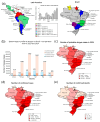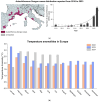Latin America's Dengue Outbreak Poses a Global Health Threat
- PMID: 39861846
- PMCID: PMC11768874
- DOI: 10.3390/v17010057
Latin America's Dengue Outbreak Poses a Global Health Threat
Abstract
Dengue fever, caused by the dengue virus (DENV), poses a significant global health challenge, particularly in tropical and subtropical regions. Recent increases in indigenous DENV cases in Europe are concerning, reflecting rising incidence linked to climate change and the spread of Aedes albopictus mosquitoes. These vectors thrive under environmental conditions like temperature and humidity, which are increasingly influenced by climate change. Additionally, global travel accelerates the cross-border spread of mosquito-borne diseases. DENV manifests clinically in a spectrum from asymptomatic cases to severe conditions like dengue hemorrhagic fever and dengue shock syndrome, influenced by viral serotype and host factors. In 2024, Brazil experienced a fourfold increase in dengue cases compared to 2023, accompanied by higher mortality. Conventional control measures, such as vector control, community engagement, and vaccination, proved insufficient as climate change exacerbated mosquito proliferation, challenging containment efforts. In this regard, our review analyzes prevention measures and therapeutic protocols during the outbreak while addressing DENV transmission dynamics, clinical presentations, and epidemiological shifts. It also evaluates diagnostic strategies combining clinical assessment with serological and molecular testing, providing information to improve diagnostic and preventive measures. The global expansion of dengue-endemic regions, including outbreaks in Europe, highlights the urgent need for enhanced surveillance, proactive interventions, and international collaboration to mitigate the growing threat of Dengue and other arboviruses like West Nile, Zika, Chikungunya, Oropouche, and Yellow Fever viruses.
Keywords: Dengue; epidemiology; outbreak; pandemic; vaccines.
Conflict of interest statement
The authors declare no conflicts of interest.
Figures








References
-
- FAO-WHO Expert Committee on Zoonoses . Zoonoses: Report of the FAO-WHO Expert Committee on Zoonoses. 3rd ed. FAO-WHO; Geneva, Switzerland: 1967.
Publication types
MeSH terms
Grants and funding
LinkOut - more resources
Full Text Sources
Medical

